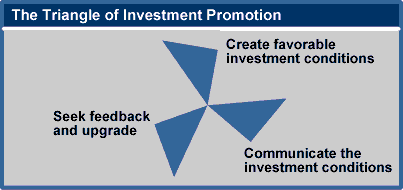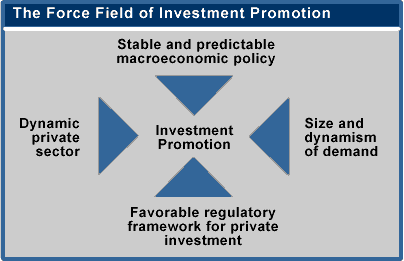Investment Promotion
Investment promotion and facilitation is about creating a favorable setting for private investment, not necessarily foreign investment only, and about getting the message that such a setting exists across to decision-makers in firms. A somewhat simplified view would suggest the following sequence:
1. Create favorable investment conditions:
- allocate dedicated real estate (e.g. industrial estates)
- create a competitive infrastructure to develop and connect the industrial estate
- make fiscal incentives and other subsidies available
- facilitate the investment by reducing and simplifying permits and licenses, and streamlining the processing of permits (including the creation of first-stop- or one-stop-agencies)
2. Communicate the investment conditions:
- publish advertisements in international trade journals
- send investment missions to potential countries of origin
- promote the location at trade fairs
- invite missions from potential countries of origin
- direct mailing to potential investors, as well as specialized consultancy firms
3. Constantly upgrade the investment conditions:
- establish fora for frequent communication with investors
- establish feedback mechanism for investors
- adapt the investment conditions to the specific needs of investors
Proceeding in this way can establish the virtuous circle which is depicted in the following figure.

This kind of approach is oriented at the typical set of criteria a firm will apply when it selects a location for a new investment. The two following tables give an overview of the kind of criteria a large multinational manufacturing firm will apply in, first, selecting an appropriate country, and, second, a location in that country.
Table 1: Criteria to Evaluate Countries in Investment Decisions
Table 2: Location-specific Criteria
However, before we take a more detailed look at this approach to investment promotion and facilitation, it is essential to mention one point: The basic attractiveness of a country is not defined by its investment promotion policy. The basic attractiveness of a country is determined by two other factors:
- The overall economic performance. Those countries attract most investment which have attractive domestic markets. For instance, the reason why FDI in China exploded since the 1980s is, first and foremost, the fact that foreign firms perceived China as a very promising market. The largest part of FDI is market-seeking, i.e. firms set up factories in countries to produce for the local market. The more attractive the local market is, the more firms will consider to set up firms.
- The image of a country. If a country has, in the course of time, established the perception among multinational firms that doing business there is convenient, there will be a reinforcing effect. FDI follows a certain herd effect. But there is more to it than that. The more foreign investors are active in a given country, the more political clout they have, in particular in terms of shaping conditions to their favor. A firm will think twice before it is the first to go to a given location. The image factor appears to be particularly relevant when it comes to export-oriented investment.
These factors explain why FDI in developing countries is so massively clustered in just two handfuls of countries: ten countries accounted for 88.2 % of FDI inflows in developing countries in the first half of the 1990s. Some of them, such as China, Brazil, and Indonesia, have large domestic markets. Other ones, such as Singapore, Malaysia, and Hong Kong, have established very positive images with foreign investors, combined with and reinforced through competent investment promotion policies.
What conclusion may we draw from this? We suggest that the most useful conclusion would be to conceptualize investment promotion in the context of the following force field.

Investment promotion activities alone do little to distinguish a location. It can do nothing about the aggregate demand in a country, and it has only limited effect in terms of building image since the image of a country is a function of the other factors. The other factors are to a certain extent mutually substitutable. Not all the countries which attract a lot of FDI are famous for their stable and predictable macroeconomic policy. Investors are, up to a point, willing to trade stable macroeconomic conditions with the access to a large market. But it is quite obvious that a country which ranks low regarding each or most of the four factors will have little chance of attracting FDI.
The one factor which may not be immediately obvious is "Dynamic private sector". In this regard, the argument goes like this. A country which does not have a dynamic private sector (or a dynamic and competitive sector of government-owned enterprises) may still attract FDI, but only of a specific variety, namely extremely low value-added, such as isolated steps of garments assembly. The income effect, as well as the structural effect, of such FDI is limited. In all other activities, a potential investor will look out for competent suppliers, subcontractors, and service providers, and if he does not find them he will look somewhere else. Accordingly, we would argue that attraction of FDI and private sector development are complementary activities.
Specific instruments regarding investment promotion are the following:
the target
group
![]()
![]() SME
support
SME
support
![]() SME pro-
SME pro-
![]() motion
motion
![]() investment
investment
![]() promotion
promotion
![]() entre-
entre-
![]() preneurship
preneurship
![]() promotion
promotion